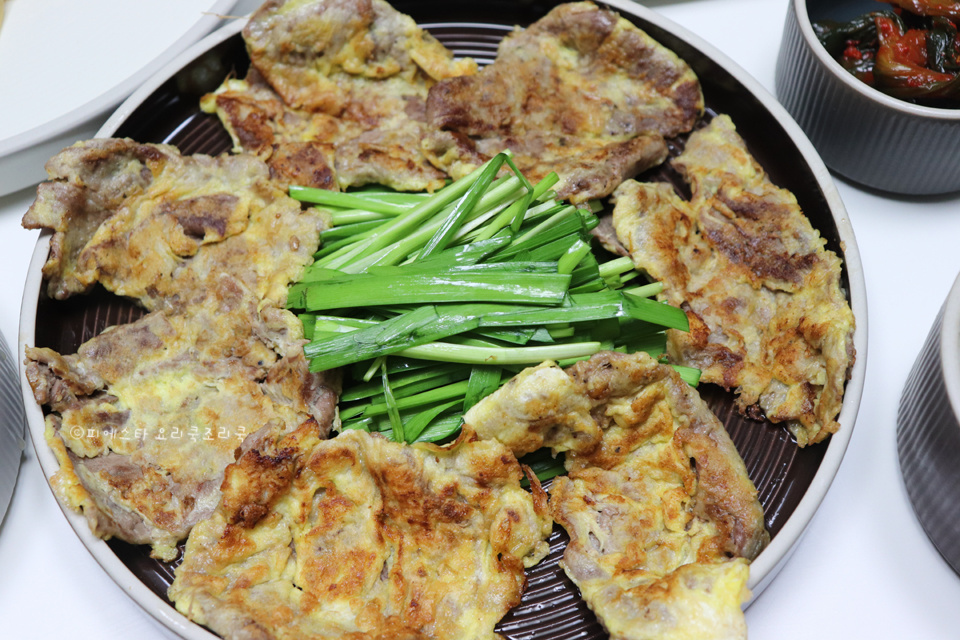Yukjeon: Thin and Tender Pan-Fried Beef
A Must-Try Delicacy! How to Make Yukjeon That You’ll Crave Again and Again ♬

Isn’t it true that pancakes and jeon (Korean savory pancakes) are best enjoyed piping hot, right off the pan, even if it means risking a burn on the roof of your mouth? Restaurants that specialize in jeon always serve them fresh off the griddle, and that taste is truly unforgettable. Today, I’m rolling up my sleeves to show you how to make delicious yukjeon at home that rivals any restaurant! Thin and tender beef, coated in a savory egg batter and pan-fried to a golden brown, makes a wonderful side dish for rice and pairs perfectly with makgeolli (Korean rice wine). Elevate your dining table with warm, freshly made yukjeon!
Main Ingredients- Beef (for Bulgogi: Eye of round, Top round, etc. – lean cuts) 1 pack (approx. 200-250g)
- Pancake Mix (Buchim Garu) 1 cup
- Sweet Rice Flour (Chapssal Garu) 1 Tbsp
- Eggs 2
- Rice Wine (Cheongju) 1/2 Tbsp
- Salt to taste
- Black Pepper to taste
- Cooking Oil (generous amount)
Cooking Instructions
Step 1
The key to making great yukjeon lies in choosing the right cut of beef. Since it’s a pan-fried dish, it’s important to select cuts that are lean and have a mild flavor. Eye of round or top round, often used for bulgogi, are excellent choices for tender and delicious yukjeon. If you visit a butcher, you can ask them to slice the beef thinly specifically for yukjeon, which makes it even more convenient.

Step 2
When cooking beef, just like with pork, the most crucial first step is to remove the blood. Properly removing the blood eliminates any gamey odors characteristic of the meat and results in a cleaner taste and texture.

Step 3
There are several ways to remove blood. For very bloody meat, you can rinse it under water, but for dishes where appearance is important, like yukjeon, using paper towels is a better method. Spread out the sliced beef, place a sheet of paper towel underneath, and cover the top with another sheet. Let it sit for about 10-15 minutes, allowing the paper towel to absorb the blood. Then, discard the blood-soaked paper towels and replace them with fresh ones to thoroughly remove the blood. For quick cooking and tenderness, it’s best if the beef slices are as thin as possible; if they are thick, gently press them thinner.

Step 4
Sprinkle a little salt and black pepper on both sides of the beef after removing the blood. This helps season the meat and also removes any unwanted odors, contributing to a more flavorful jeon.

Step 5
Now it’s time to coat the beef. I prefer using pre-made pancake mix (buchim garu) because it’s already seasoned, making it more convenient. Adding one tablespoon of sweet rice flour (chapssal garu) to the mix is a wonderful trick; it ensures the jeon stays deliciously chewy even when served cold. If you don’t have buchim garu, you can use regular flour mixed with a pinch of salt, but definitely add the sweet rice flour. Spread the buchim garu and chapssal garu on a wide plate. Dip each slice of beef into the flour mixture, coating both sides thinly. It’s best to coat only a few slices at a time and gently shake off any excess flour. This ensures a thin, crispy coating.

Step 6
The final step for making yukjeon is preparing the savory egg batter. Whisk 2 eggs with 1/2 tablespoon of rice wine (cheongju) until well combined. Adding rice wine is a great way to eliminate any eggy smell, resulting in a cleaner flavor. For an even smoother texture or a cleaner taste, you can strain the egg mixture through a sieve. However, if you’re short on time, using it as is will still yield delicious results.

Step 7
Ready to pan-fry? Heat a moderate amount of cooking oil in a pan over medium heat. Too little oil will cause sticking, and too much heat will burn the jeon. Dip the thinly coated beef slices into the egg batter and carefully place them in the hot pan. Fry on both sides until golden brown. Cooking over medium heat allows the inside to cook through without burning the exterior. Avoid using high heat, as it can scorch the outside while leaving the inside raw.

Step 8
Overcooking yukjeon can make it tough. The secret to tender yukjeon is a thin coating and quick frying. I personally prefer a thin batter so that the beef’s natural flavor shines through, complemented by the tender egg coating. Once golden brown, slice the yukjeon into bite-sized pieces and arrange them on a plate. Thinly sliced yukjeon not only looks appealing but is also easier to eat.

Step 9
Yukjeon is delicious on its own, but it can be even more enjoyable with accompanying vegetables or dipping sauces. Try serving it with a lightly seasoned chive salad (buchu muchim) with soy sauce, sugar, and vinegar – the refreshing acidity cuts through the richness beautifully. A fresh, spicy scallion salad (pajeori), often served with samgyeopsal, also pairs wonderfully. Alternatively, thinly sliced onions with a simple soy-vinegar dipping sauce (cho-ganjang) add a refreshing zest that enhances the flavor of the yukjeon. Enjoy this special dish with your favorite accompaniments!




